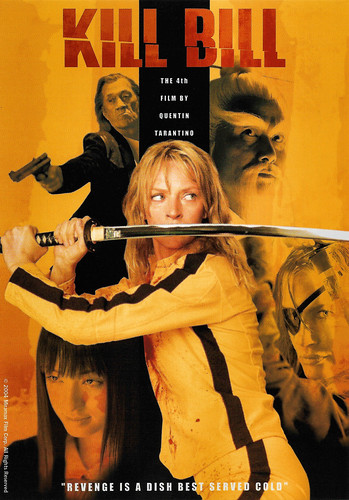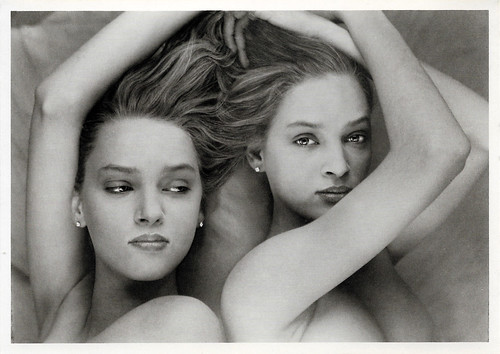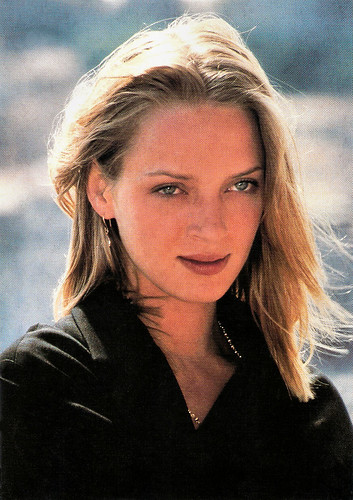
French postcard by Sonis, no. C. 492. Photo: Bac Films. Uma Thurman on the French poster for Pulp Fiction (Quentin Tarantino, 1994). Caption: Affiche du film.

British postcard by Pyramid Posters, Leicester, no. PC 9471. Photo: Miramax Films / A Band Apart. Uma Thurman (montage) in Kill Bill (Quentin Trantino, 2003). Caption: The 4th film by Quentin Tarantino. "Revenge is a dish best served cold".

German postcard by Edgar Medien. Photo: Buena Vista International. Uma Thurman in Kill Bill: Vol. 2 (Quentin Tarantino, 2004). Caption: The bride is back to finish her work.
An homage to Botticelli's The Birth of Venus
Uma Karuna Thurman was born in 1970 in Boston, Massachusetts, into a highly unorthodox and internationally-minded family. She is the daughter of Nena Thurman (née Birgitte Caroline von Schlebrügge), a fashion model and socialite who now runs a mountain retreat, and of Robert Thurman (Robert Alexander Farrar Thurman), a professor and academic who is one of the nation's foremost Buddhist scholars.
Uma grew up in Amherst, Massachusetts, where her father worked at Amherst College. Thurman's household was one in which The Dalai Lama was an occasional guest; she and her siblings all have names deriving from Buddhist mythology; and Middle American behaviour was little understood, much less pursued. And so it was that the young Thurman confronted childhood with an odd name and eccentric home life - and nature seemingly conspired against her as well.
She is six feet tall, and from an early age Uma towered over everyone else in her class. The family constantly relocated, making the gangly, socially inept Thurman perpetually the new kid in class. The result was an exceptionally awkward, self-conscious, lonely, and alienated childhood. Unsurprisingly, the young Thurman enjoyed making believe she was someone other than herself, and so thrived at acting in school plays.
This interest, and her lanky frame, perfect for modeling, led the 15-year-old Thurman to New York City for high school and modeling work (including a layout in Glamour Magazine) as she sought acting roles. The roles soon came.
She made her film debut in the teen thriller Kiss Daddy Goodnight (Peter Ily Huemer, 1987). It was followed by Terry Gilliam's interesting box office bomb, The Adventures of Baron Munchausen (1988), starring John Neville. She made a brief appearance as the goddess Venus, and during her entrance, she briefly appears nude, in an homage to Botticelli's 'The Birth of Venus'.
Then followed her breakthrough in Dangerous Liaisons (Stephen Frears, 1988) from a screenplay by Christopher Hampton, which was based on the 1782 French novel 'Les liaisons dangereuses' by Pierre Choderlos de Laclos. The period romantic drama, starring Glenn Close, John Malkovich, and Michelle Pfeiffer, brought much attention to her unorthodox sensuality. Her performance intriguingly combined innocence and worldliness. The weird, gangly girl became a sex symbol virtually overnight.

American postcard by Fotofolio, New York, N.Y., no. JC13. Photo: John Chan, 1988.

Vintage postcard, no. 2068. Caption: Sweet 'n sexy.
That most unorthodox of all gangster's molls
Uma Thurman continued to be offered good roles in Hollywood pictures into the early 1990s, the least commercially successful but probably best-known of which was her smoldering, astonishingly-adult performance as June, Henry Miller's wife, in Henry & June (Philip Kaufman, 1990), the first film to actually receive the dreaded NC-17 rating in the USA.
After a celebrated start, Thurman's career stalled in the early 1990s with films such as the mediocre Mad Dog and Glory (John McNaughton, 1993) with Robert De Niro. Worse, her first starring role was in Even Cowgirls Get the Blues (Gus Van Sant, 1993), which had endured a tortured journey from cult-favorite book to big-budget film and was a critical and financial debacle.
Uma bounced back with a brilliant performance as Mia Wallace, that most unorthodox of all gangster's molls, in Tarantino's lauded, hugely successful Pulp Fiction (Quentin Tarantino, 1994). For her role, Thurman was nominated for the Academy Award, the BAFTA Award, and the Golden Globe Award for Best Supporting Actress. She took little advantage of her new-found fame by choosing not to do any big-budget films for the next three years.
She starred in the independent period drama A Month by the Lake (John Irvin, 1995) opposite Vanessa Redgrave and Edward Fox, and supporting roles in which she has lent some glamorous presence to a mixed batch of films, such as Beautiful Girls (Ted Demme, 1996) with Matt Dillon, and The Truth About Cats & Dogs (Michael Lehmann, 1996).
She played supervillain Poison Ivy in the reviled Batman & Robin (Joel Schumacher, 1997) with George Clooney, and Emma Peel opposite Ralph Fiennes as John Steed in a remake of The Avengers (Jeremiah Chechik, 1998). She worked with Woody Allen and Sean Penn on Sweet and Lowdown (1999) and starred in Richard Linklater's drama Tape (2001) opposite husband Ethan Hawke. Thurman also won a Golden Globe award for her turn in the made-for-television film Hysterical Blindness (2002), directed by Mira Nair.

Vintage postcard, no. 2102. John Travolta and Uma Thurman in Pulp Fiction (Quentin Tarantino, 1994). Caption: John n Uma at table.

Vintage postcard in the Cinemascope Collection, no. 65. Uma Thurman as Poison Ivy in Batman & Robin (Joel Schumacher, 1997).

German postcard by Edgar Medien. Photo: Vox. Uma Thurman and Ralph Fiennes in The Avengers (Jeremiah S. Chechik, 1998). Caption: Uns sendet die Queen.
Revenge on a team of assassins
A return to the mainstream spotlight came when Uma Thurman re-teamed with Quentin Tarantino for Kill Bill: Vol. 1 (2003). The two had dreamed up this two-part revenge action film on the set of Pulp Fiction (1994). Thurman starred as the Bride, who swears revenge on a team of assassins (Lucy Liu, Michael Madsen, Daryl Hannah, and Vivica A. Fox) and their leader, Bill (David Carradine) after they try to kill her and her unborn child.
She then turned up in the John Woo cautioner Paycheck (2003) that same year. The renewed attention was not altogether welcome because Thurman was dealing with the break-up of her marriage with Hawke at about this time. Thurman handled the situation with grace, however, and took her surging popularity in stride.
She garnered critical acclaim for her work in Kill Bill: Vol. 2 (Quentin Tarantino, 2004) and was hailed as Tarantino's muse. The two Kill Bill films brought her two additional Golden Globe Award nominations.
Thurman reunited with Pulp Fiction dance partner John Travolta for the Get Shorty (Barry Sonnenfeld, 1995) sequel Be Cool (F. Gary Gray, 2005). Despite a lukewarm critical reception, the film grossed US$95 million.
She played Ulla in the remake of The Producers (Susan Stroman, 2005). In 2006, she was made a Knight of the Order of Arts and Letters (Chevalier De l'Ordre Des Arts Et Des Lettres) by France. For her five-episode role in the musical TV series Smash (2012), Thurman received a Primetime Emmy Award nomination for Outstanding Guest Actress in a Drama Series.
Her later films include Lars von Trier's Nymphomaniac (2013) and The House That Jack Built (2018). She made her Broadway debut in Beau Willimon's political drama 'The Parisian Woman' (2017-2018) at Hudson Theatre. For her role, she won the Broadway.com Audience Award for Favorite Leading Actress in a Play.
In 2018, in a New York Times interview, Thurman revealed that Harvey Weinstein had sexually assaulted her in 1994. Uma Thurman was briefly married to Gary Oldman, from 1990 to 1992. In 1998, she married Ethan Hawke, her co-star in the offbeat futuristic thriller Gattaca (Andrew Niccol, 1997). The couple has two children, Levon and Maya. Hawke and Thurman filed for divorce in 2004.

British postcard by Anabas, Essex, no. AP578, 1997.

British postcard by Pyramid, Leicester, no. PC 8457, 1999.
Sources: Wikipedia and IMDb.
No comments:
Post a Comment